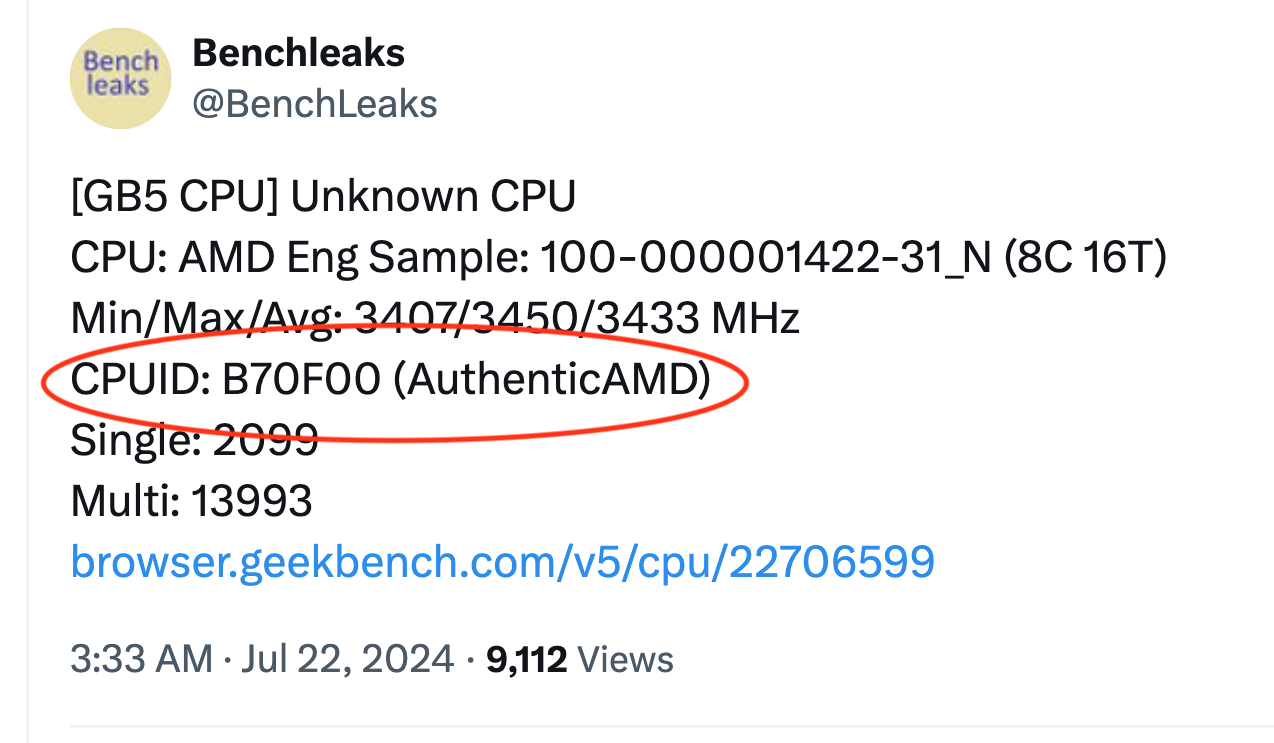
With all the attention at Santa Clara-based AMD focused on the imminent release of its Strix Point chips — and the oft-repeated claim they can beat Apple in chip performance — it might be easy to overlook what a different, even more powerful chip from AMD could offer.
It'd be easy to overlook — unless a few MacBook-competing performance stats emerged. That's what happened this week. The highly anticipated Strix Halo has reared its head.
AMD Strix Halo APU leaked benchmarks
According to a listing on Geekbench posted by the bot @benchleaks on Monday, two different models of a new AMD chip — apparently the AMD Strix Halo — ran through the Geekbench 5.4.1 overall performance test.
One run featured a multi-core score of 13,993 (single-core score: 2,099), and the run hit a multi-core score of 7,934 (single-core score: 2,099).
As these chips are in development, Laptop Mag has no way to verify these findings. What's more, the Twitter bio for @benchleaks advises, "Expect spam and don't trust any posted values."

X user and data leaker @HXL linked the test results to an upcoming AMD chip, the so-called Strix Halo, by asserting the CPUID associated with Strix Halo (B70F00).
AMD's new APU (accelerated processing units) chipsets target AI performance, but what does their overall performance mean for the average user?
Unlike the typical laptop, which separates its CPU and GPU, the APU combines the two chips into a single chip.
This is similar to what Apple does with its M-series chips, except Apple uses a SoC ("system on a chip"), which combines the CPU and GPU and everything between onto a single chip.
Before we jump into comparisons, it's important to note a few things. First, we do not know which models of the Strix Halo these scores represent. Second, these are not a final representation of the performance of these chips.
We've seen too many times where preproduction units never provide an accurate depiction. Third, Geekbench 5 is an older test that doesn't measure performance as well as Geekbench 6.
On Geekbench 6, the MacBook Air 13 M3 scored 12,087. For additional context, Geekbench 6 tests typically produce higher scores than Geekbench 5. So the Strix Halo beat the M3 even with that disadvantage.
However, jumping to the M3 Pro, it scored 14,357. Again, that's pretty tight, considering the Strix Halo's disadvantage.
But with the M3 Max, the jump to Geekbench 6 isn't going to help AMD's Strix Halo against the M3 Max's incredible performance score of 20,863.
In May, X user @Olrak_29 created a render of what the Strix Halo may look like, which you can view below:
Oh shit it's not actually Vega 64 https://t.co/oYLgOzee3V pic.twitter.com/4E4IU8iGcvMay 17, 2024
Outlook
This isn't the final look at the AMD Strix Halo APU, and take every leak — especially from a bot that scans Geekbench tests — you see with a dose of skepticism.
However, I hope the Strix Halo plans to compete with the Apple M4, especially since the Halo is speculated to launch at CES 2025.
Back in April, there was a claim by a Taiwanese manufacturer that the AMD Strix Halo's GPU is comparable to the Nvidia GeForce RTX 4060 GPU.
That means if the AMD Strix Halo APU is slated to drop into premium laptops similar to the MacBooks, it could mean that regular laptops could be as strong or stronger than some gaming laptops. That's an exciting notion.
And while unlikely, it'd be a gamer's dream to see something like the AMD Strix Halo APU in a handheld gaming PC like an Asus ROG Ally X.
Meanwhile, the AMD Strix Point chips, the Ryzen AI 9 HX 370 and Ryzen AI 9 365, will be available in laptops starting Sunday. (The Asus Zenbook S 16, ProArt PX13, and new ROG Zephyrus G16 among them.)







